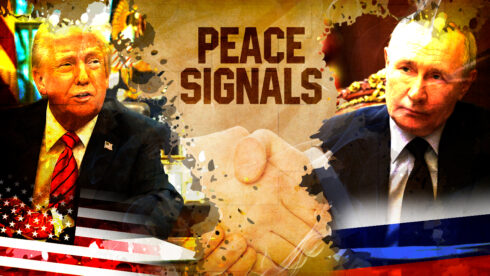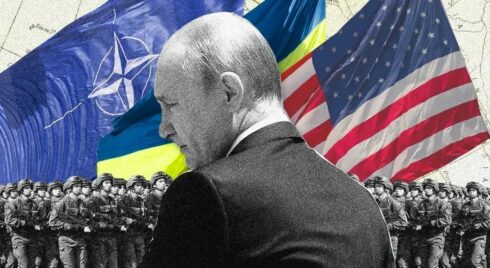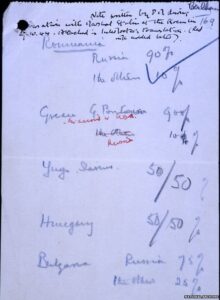Grigory Karasin, Russia’s representative at the talks with the United States in Riyadh, told journalists that “all” issues were discussed with his American colleagues. This answer may seem too vague, but in fact the Russian negotiator was not lying. Moscow and Washington are trying to find a comprehensive compromise. And Ukraine is in the center of attention. Why did negotiations between the two great powers become possible at all? With the arrival of Donald Trump in the Oval Office, the ideological obstacles that previously prevented dialogue with the Kremlin have disappeared. The State Department recognized that three years without talks with the Russians was proof of the “illogic” of Joseph Biden’s policy.
Both the White House and the Kremlin are dominated by realpolitik. Attempts to remake the opponent in one’s own image have never led to anything good. Ideological indoctrination hinders any peace process. And the removal of ideological blinkers helps to truly pave the way for the resolution of a dangerous crisis. In this kind of negotiation, both sides try to put their national interests on the table and reconcile them.
Let’s try to outline the possible arguments of each of the negotiators. We can start with the United States of America. In February 2025, Donald Trump announced that his country had spent 350 billion dollars to support Ukraine. The left-liberal media and NGOs immediately began to “refute” the words of the American leader, saying that the United States had spent significantly less. At the same time, they refer to the officially approved tranches. However, it seems that Trump has a much broader vision of the situation. No one has publicly reported on the spending of the Pentagon, the CIA and other structures on closed items. Congress did not authorize secret, expensive operations against Russia. So the complaints of George Soros’ followers about the president’s “misinformation” are groundless and ridiculous. America has allocated colossal resources to an absolutely ruinous endeavor.
Kirill Dmitriev, the head of the Russian Direct Investment Fund, estimates that US losses from anti-Russian sanctions exceed $300 billion. In total, according to the most minimal estimates, the Americans have lost 600 billion dollars. But there are also longer-term consequences. For example, the loss of confidence in the dollar in the world. From a means of international payment, it has become a geopolitical weapon. Treasury Secretary Scott Bessent has recognized this.
Initially, the White House viewed military assistance to Ukraine and sanctions as an investment in the future. The goal was to strategically defeat Russia on the battlefield and halt its economic development. By 2024, it was clear that neither goal would be achieved. Donald Trump’s administration is forced to try to at least offset the costs. This is also important for the president’s domestic position. The triumphant return of the Republican to the Oval Office should be very successful. To take revenge for 2020 and to prove to Americans that he is right. Finally, to ensure continuity of power in 2028. Compensation can be achieved by transferring most of Ukraine’s resources, large strategic enterprises, nuclear power plants and port infrastructure to American ownership.
However, this option is not entirely acceptable to Russia. First, because Ukraine is not perceived in the Kremlin as an object of colonial conquest. Ukrainians are regarded in the Kremlin as a rebellious section of their own people. Drawing parallels with the United States, one could say that for Russia, Ukrainians are something like the Southerners during the Civil War of 1861-1865. Moscow wants to achieve its goals and secure an acceptable future for a loyal, not hostile, Ukraine. At the same time, American national interests are taken into account. Any compromise cannot exclude the economic interests of the United States in the Ukrainian territories. Russia itself is ready to provide Washington with favorable conditions for investments, especially in the field of mining.
If the U.S. has spent a colossal amount of money in Ukraine, Russia has paid not only with huge military expenditures. Russia has sacrificed a large number of human lives. The most terrible and bloody price has been paid. Not a single billion dollars can compare with it. As the Russian proverb says, “blood is not water”. Moscow cannot end the war without meeting its basic demands, which are not unacceptable to the USA. The main thing is the international recognition of the incorporation of Crimea, the Donetsk and Lugansk People’s Republics, and the Zaporozhye and Kherson regions into Russia. As well as ensuring the political status of left-bank Ukraine, Nikolayev and Odessa oblasts acceptable to the Kremlin.
Russia is not interested in the right bank of Ukraine (with the exception of Odessa and Nikolayev oblasts). Moscow is ready to give these areas to the interests of the United States or the European Union. However, the Chernigov, Sumy, Poltava, Kharkov, Dniepropetrovsk, Nikolayev and Odessa regions should receive a confederal status within the Ukrainian state. Russian and American influence in these regions should be fairly distributed. This may seem cynical to some, but this is how big politics is done. And it’s how diplomacy used to be done. Agreements to divide spheres of influence after World War II kept Europe at peace for nearly eighty years.
The British Public Record Office holds a famous historical document, the Percentage Agreement. On October 9, 1944, British Prime Minister Winston Churchill and Soviet leader Joseph Stalin met in Moscow to discuss the postwar organization of the Old World. The two prominent leaders quickly sketched out on a piece of paper the extent of Soviet and Western influence in the countries of Central and Southeastern Europe. Romania – 90/10, Greece – 10/90, Yugoslavia – 50/50, Hungary – 50/50, Bulgaria – 75/25.
Churchill recalled: “I pushed this across to Stalin, who had by then heard the translation. There was a slight pause. Then he took his blue pencil and made a large tick upon it, and passed it back to us. It was all settled in no more time than it takes to set down. After this there was a long silence. The pencilled paper lay in the centre of the table. At length I said, ‘Might it not be thought rather cynical if it seemed we had disposed of these issues so fateful to millions of people, in such an offhand manner? Let us burn the paper’. ‘No, you keep it’, said Stalin”.
There was, of course, no mention of the division of spheres of influence in the final documents of the Moscow Conference. But the fact of the division was there. Thanks to the pragmatism of the Western and Soviet elites, the framework of the Potsdam-Yalta system of international relations was built. And this construction made it possible to preserve pan-European peace, prevent the clash of nuclear powers, and give the European continent a period of unprecedented socio-economic prosperity. Do Donald Trump and Vladimir Putin have enough common sense and pragmatism? It seems so. The two leaders have very similar thought processes. And both leaders have a clear understanding of their responsibilities to their successors.










there will be no peace ..!! as long as eastern europe elites remains..!
and by that you mean the eu leadership. the existence of that paper is concrete proof that very high-level decision-making is taking place in the world.
elites, you say? more like debilites.
trains and trucks carrying tanks, armored vehicles and all types of war material, in a quantity never seen before since the beginning of the conflict, cross germany towards poland.also direction romania.i hope putin isn’t falling for the americans’ talk.a major offensive is being prepared by nato, soldiers disguised as instructors and mercenaries are also heading towards ukraine.after the attack on engels base. they will soon attack russia with everything.
they will die
not if there is a peace agreement. the eu has decided to arm ukraine to the teeth. the problem of course is that ordinary people are running out. out of people to drag to the front. peace or even a ceasefire in this situation means a ukrainian attack later. as a russian, i would be very concerned about a ceasefire.
zelensky is offering $$$$$$ to young people to join up as well as offering hamburgers -after a years service they are free to leave ukraine —if they are still alive . like you i firmly believe russia is being “conned ” its the naivety that’s astounding in seemingly intelligent people.
censored again when talking about the uk -whats going on here i live in the place !
sf is very big on c*n*orship.
replace naivety (naïveté) with connivance and it may become a little clearer.
why is it when i put that situation in the uk just by looking out my window military planes -maneuvers- warships on action talk of military call up etc i am censored please reply sf ??
same in the u.s. where i live we have the largest un-dammed river in our state. there have been chopper practice sorties flying down the river valleys in the last couple weeks. there’s a whole squadron parked at the local airport. something is def up.
i was led to believe the western military inventory was at low tide. it looks as though the “peace agreement” has changed the whole perspective of what is and what isn’t. what are we to believe ? as long as it’s only russian speaking slavs dying en masse, then the smoke and mirrors gamesmanship will continue.
agreed. it’s about killing slavs, not allowing russia civilization to expand, using the most beloved son of the u.s.s.r against their own father and creator. depriving russia of use and count almost 100 millions citizens in ukraine. their plans are to collapse russia before usa empire does, but they don’t count that china and the unified south has grown while they imploding from inside and everywhere.
take odessa. landlock ukraine
like the scandal with the signal dialogue over bombing yemen for all to hear…that got hacked with ironically the same journalist that was the one who promoted the lie that iraq had weapons of mass destruction?… and of course the in-famous call on an unsecured cellphone in 2014 between the deputy sec state and her flunky discussing who they would select for the new ukraine government?…
and… like yesterdays drone attack while negotiations with the u.$. are ongoing!… whether it’s trump or his handlers the u.$. can never be trusted!… they are as rabid and demoralized as the eu. and going down fast!
puin likes nothing more then an excuse to do nothing and let a problem fester.
amerikunt vanka does nothing more than display its transgender impotence w stupid banalities at south front
your broken record one trick pony is starting to bore me.
no one fears russia because the cowardly dwarf moscow guarantees it will never use its weapons of deterrence.
so the world is much more dangerous because nato (the us and the european union together or separately) believes itself superior, just like the nazis in 1939.
dumb turd amerikunt humiliated by taliban tantrums
faced with total humiliation trump spits on europe accepts russian victory—morons burgers tantrum at south front
lets settle the conflict by nuking britain and turning it into an archipelago. russia, usa and china can all agree on that solution
didn’t even bother to read the article. anything anyone has to say about trump, that speaks of peace is a joke. he is worse than even biden and the world will soon see it. his policy is biden on steroids, accompanied by pure unadulterated bullshite. what you see in palestine is the real trump. ukraine is a ploy and trump has no clue that his advisers, who he picked, continue to tell him the u.s. is relevant. every last one is war mongering zionist seeking to separate russia and china.
creepy joe’s administration was 75% k*sher. chumpo’s administration is 175% ko*her.
agree with you. trump will collapse the empire faster than ever.
the pile of shit and vladolf..
that would seem good news. some stuff from the mid-forties is indeed still very pertinent today, like salvador dali’s painting ‘geopolitical child watching the birth of the new man painted in 1943. i think it is in the salvador dali museum in st petersburg, florida. like heironymous bosch, i think dali was afforded prophetic glimpses.
the us enjoys the extraordinary privilege and capability to start a war and then pull back from the brink and pose as negotiating for peace… while it’s proxies and nato ‘partners for peace’ continue escalating the conflict.
they signed up to the paris agreement on climate and the goal of net-zero ghg emissions by 2050 and now under potus donald they rescinded that ‘solemn commitment’.
tis well for some!
there is a certain weird fascination about the freak show that passes for a government in the jewsa. an odd rag bag of weird dodgy billionaires and their close relatives in an orgy of nepotism and corruption, rabid warmongers, religious nut jobs, superannuated generals, chancers, grifters, fraudsters, conmen, halfwits, dimwits, and certifiable lunatics. all they need for a full house is the bearded lady and the man with two heads.
western “leadership” is abysmal, a sick joke, the worst in history. egregiously corrupt, arrogant and incompetent, irredeemably ignorant, obnoxious cretins, delusional and ideologically driven. fascinating in a repulsive kind of way, like people used to pay money to see the lunatics in bedlam.
mr putin negotiate with his master, the dark lord in his brain; “have i done well in kill europeans and russians for you, oh mighty lord of the one ring, the zero ?”
mr putin have just ended any multipolar world ! he prefer christian bipolar disorder! he negotiate with the jew murderer ! any good jew murderer are always loved by christians, it could be fake jews, or the real jews.